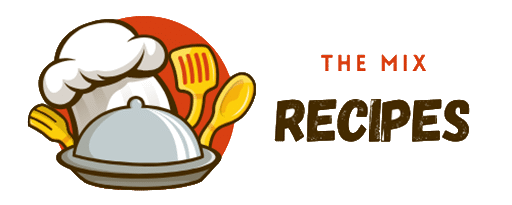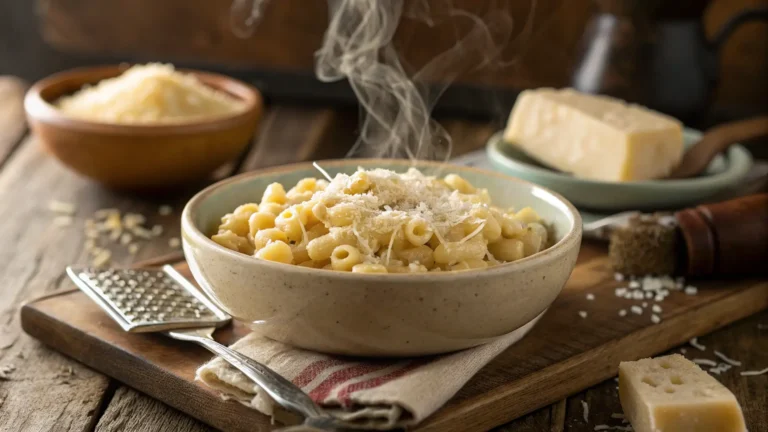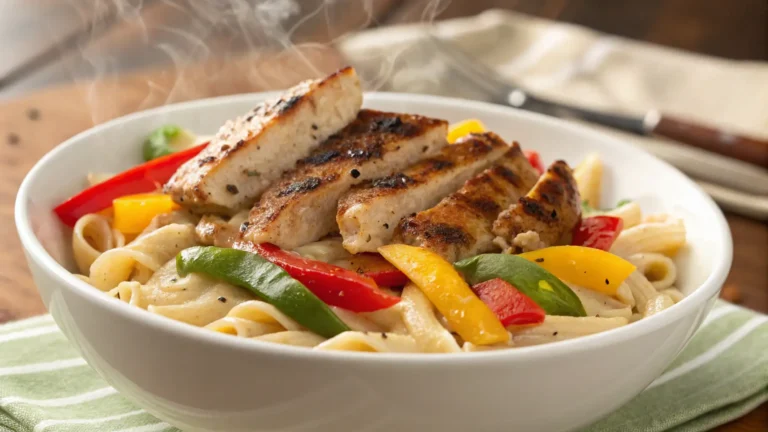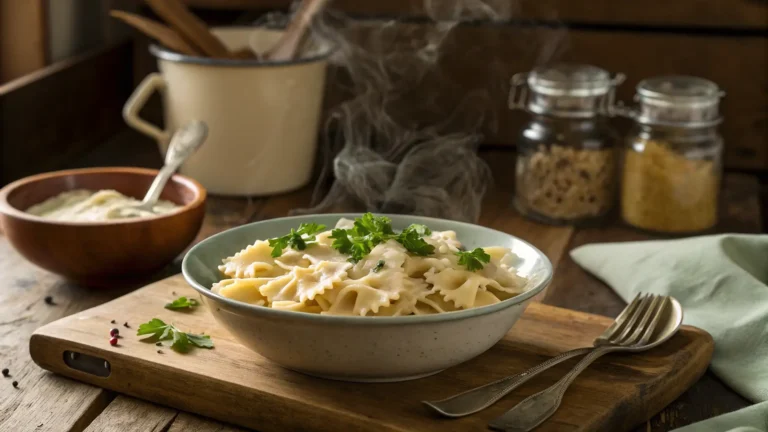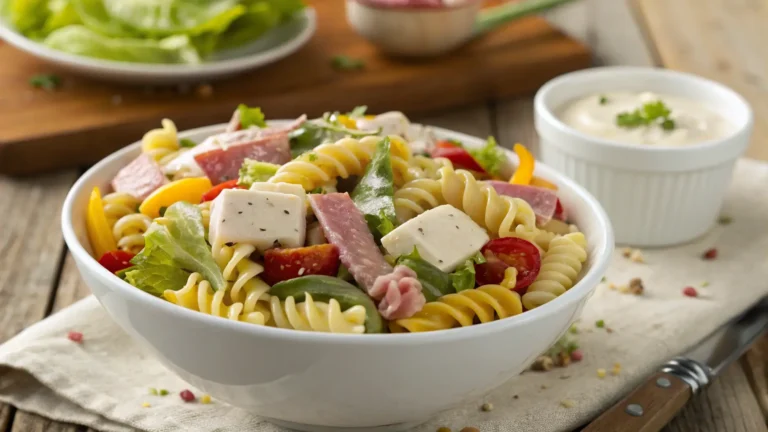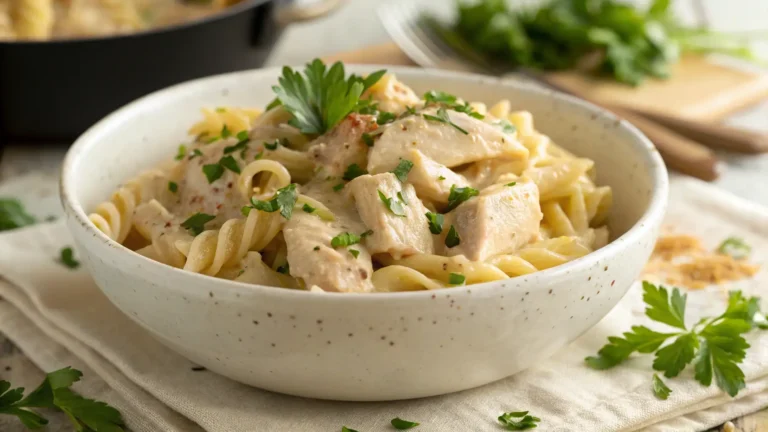Classic Pasta and Peas Recipe: A Simple Italian Favorite Done Right
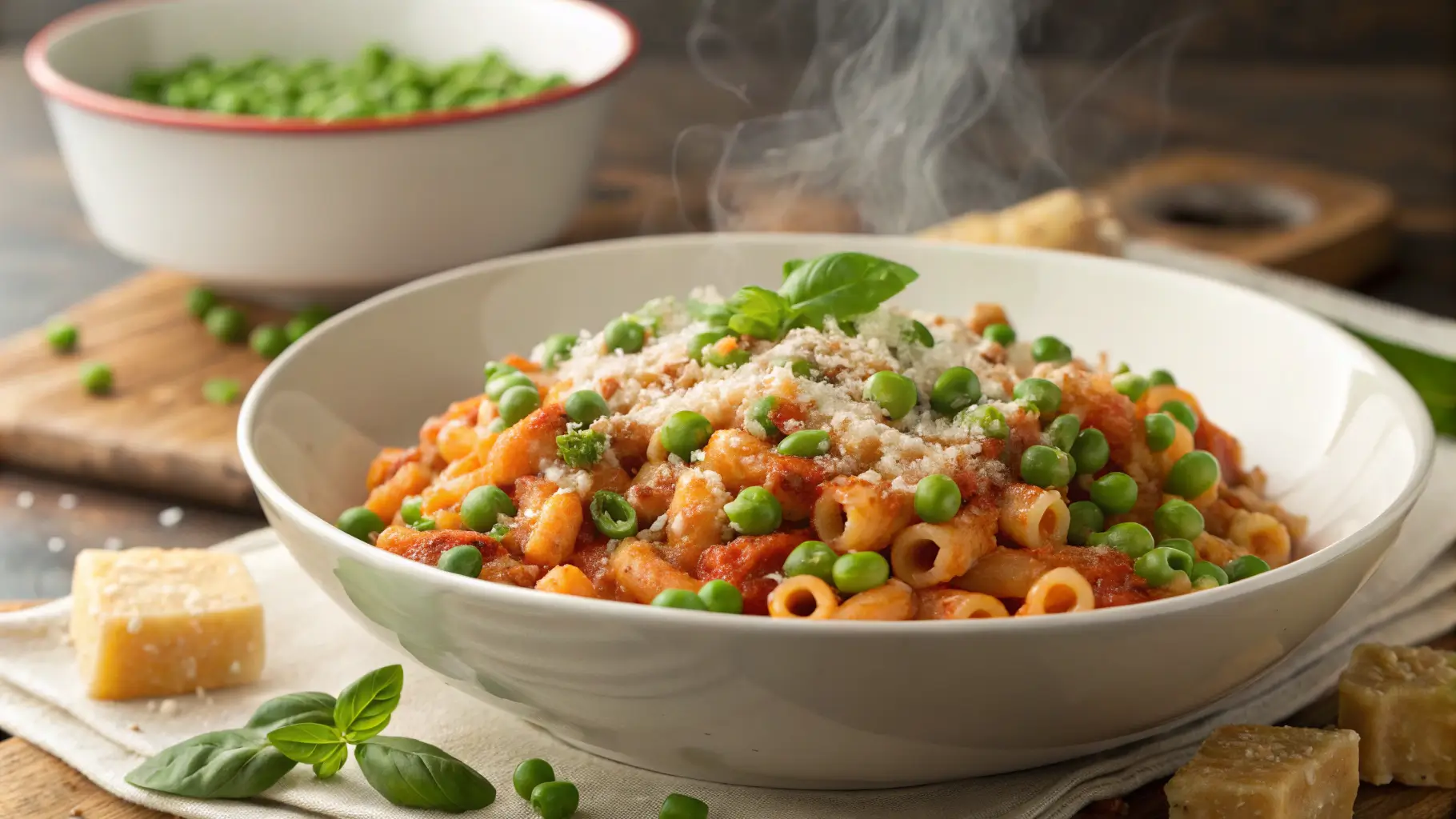
Table of Contents
The pasta and peas recipe is one of Italy’s best-kept secrets—a classic comfort dish that comes together in one pot and under 30 minutes. With just a few humble ingredients like pasta, peas, olive oil, and onion, this flavorful combination delivers maximum taste with minimal effort. Whether you’re new to Italian cooking or want a go-to pantry meal, this pasta and peas recipe is sure to earn a spot in your weekly rotation.
Looking for inspiration? Try this dish alongside a protein from our Ultimate Wagyu Ground Beef Recipe Guide to create a balanced, filling dinner.
The Timeless Appeal of Pasta and Peas Recipe
Why Pasta and Peas Is More Than Just Comfort Food
At first glance, the pasta and peas recipe might seem like a basic meal. But in Italian households, this dish is revered. It’s a staple that turns a few ingredients—dried pasta, green peas, onion, and water—into something truly comforting and creamy. That creamy texture? It comes not from heavy cream, but from the natural starches in the pasta mingling with the sweet, tender peas.
This recipe isn’t just about taste; it’s about tradition. It’s a beloved weeknight meal that spans generations, made often during busy workweeks or when the pantry is running low. The best part? It’s a one-pot meal, which means fewer dishes and faster cleanup.
The Cultural Significance of Pasta and Peas in Italian Homes
Known in Italy as pasta e piselli, this dish is a symbol of comfort, resilience, and everyday ingenuity. Southern Italian families, especially in Naples, often cook this dish during the spring when fresh peas are in season—but many make it year-round using frozen peas for convenience. Each family might have its own take on the pasta and peas recipe, with some adding garlic, pancetta, or even tomato.
Don’t miss our Best Venison Steak Recipes for more rustic Italian-influenced meal ideas.
Even though it’s modest in ingredients, the pasta and peas recipe offers a big return on flavor. It’s warm, filling, and deeply nostalgic—often associated with the smell of onions sautéing in olive oil and childhood dinners around the table. If you’re looking to reconnect with simple, heartfelt food, this is it.
Ingredients That Make the Dish Authentic

Choosing the Right Pasta Shape for Pasta and Peas Recipe
The beauty of a great pasta and peas recipe lies in the details—starting with the pasta. While any short pasta can technically work, Italians often reach for ditalini, small shells, or tubetti. These shapes are ideal because they trap bits of peas and soak up that naturally creamy broth made from the pasta starch. Want something heartier? Small elbow macaroni or even broken spaghetti will do in a pinch.
The key is size: go for pasta that’s small enough to cook evenly with the peas and doesn’t overwhelm the dish. Avoid large noodles like rigatoni or fettuccine—they’ll throw off the texture and balance. For a true one-pot success, aim for pasta with a cook time that matches your peas’ tenderness. This way, everything finishes together without turning mushy.
If you’re craving meat alongside this recipe, discover great ideas like our Best Smoked Fish Brine Recipe to complete your table.
Fresh, Frozen, or Canned: Which Peas Work Best?
Here’s the scoop: frozen peas are your best friend in this dish. They’re sweet, tender, and available year-round. Just toss them in during the last 3–4 minutes of cooking, and they’ll hold their shape and vibrant green color beautifully.
If you’re lucky enough to get your hands on fresh peas during spring, definitely use them. Shell them just before cooking for peak sweetness. However, you’ll want to boil them a few minutes longer than frozen ones to reach that perfect soft-but-firm bite.
Canned peas? Use them only if you’re in a pinch. They tend to be too soft and slightly metallic-tasting, which can throw off the fresh, clean flavor profile of a classic pasta and peas recipe.
Pro tip: If using canned peas, rinse them well and add them at the very end of cooking to avoid total breakdown.
This part of the dish may seem small, but the pea choice truly shapes the entire flavor experience. And when in doubt, go frozen—they’re quick, reliable, and retain the most color and bite when handled correctly.
Step-by-Step Pasta and Peas Recipe
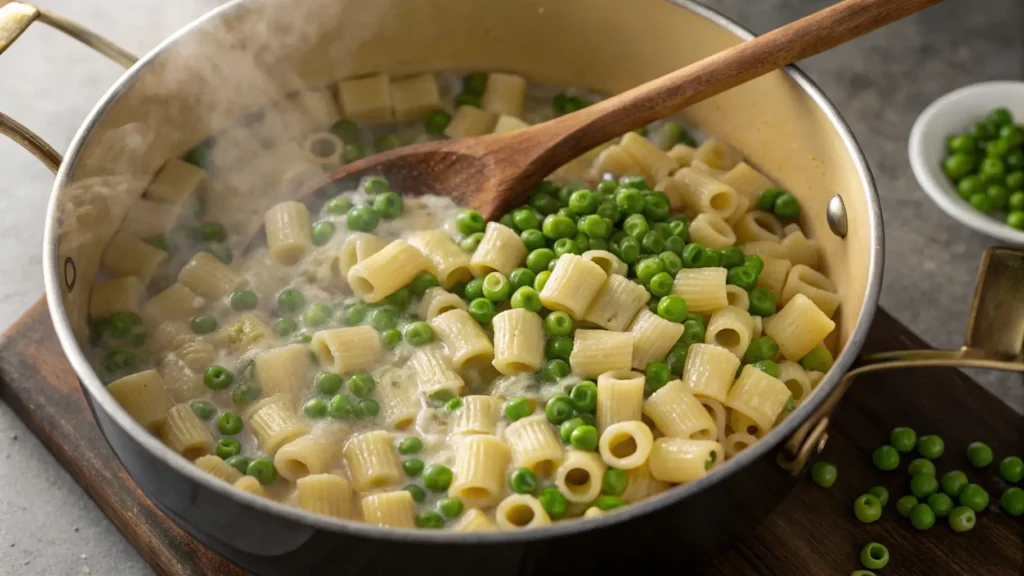
How to Cook Pasta and Peas Together the Right Way
One of the many reasons the pasta and peas recipe has earned its beloved status is its one-pot simplicity. You don’t need multiple pans or complicated techniques. Everything—from sautéing to simmering—happens in a single pot, and the result is creamy, hearty, and packed with flavor.
By cooking the pasta directly with the peas in broth, the dish thickens naturally thanks to the pasta’s starch. This one-pot method isn’t just easy—it’s traditional, and it maximizes flavor.
Ingredients (Serves 4)
- 1 cup ditalini or any small pasta
- 1½ cups frozen peas
- 1 small onion, chopped
- 2 tbsp olive oil
- 3 cups vegetable or chicken broth
- Salt and black pepper, to taste
- Optional: garlic, pancetta, or grated Parmesan
Instructions
- Heat olive oil in a pot over medium heat. Add onion and sauté until soft and golden.
- Stir in peas and let cook for a minute or two.
- Pour in broth, bring to a boil, and stir in your pasta.
- Simmer until pasta is al dente—about 10–12 minutes.
- Season with salt and pepper, mash a few peas to thicken the broth if desired.
- Serve your creamy pasta and peas recipe hot, topped with Parmesan and fresh herbs.
This technique helps the pasta and peas recipe come together quickly while allowing the pasta to soak up all that savory goodness. It’s a cozy, wholesome meal made for busy weeknights—or lazy Sundays.
Tips for Making It Creamy Without Cream
What makes this pasta and peas recipe stand out is that it gets rich and creamy without needing cream at all. The starch from the pasta naturally creates a silky broth when cooked in minimal liquid.
Here’s how to nail the texture:
- Use broth over plain water. It builds more flavor into the base.
- Mash some peas. It thickens the sauce without changing the taste.
- Avoid overcooking. You want the pasta to hold its shape and absorb the broth, not turn mushy.
- Stir often. This prevents sticking and encourages starch release.
This is why so many Italian home cooks stick to this pasta and peas recipe—it’s simple, smart, and satisfying. Pair it with bread, a glass of white wine, or even grilled chicken for a fuller meal.
Looking for inspiration? Try this comforting dish alongside our Smoked Fish Brine Recipe to balance earthy and smoky flavors beautifully.
Variations Across Italy
Neapolitan Pasta e Piselli: The Southern Twist
In Naples, the pasta and peas recipe is known as pasta e piselli and carries a strong regional identity. Southern Italians keep it simple and affordable, often skipping cheese or meat entirely. The flavor comes from sautéed onions, olive oil, and the natural sweetness of peas cooked low and slow.
One unique touch? Some Neapolitans add a small amount of tomato paste or diced tomatoes. This doesn’t turn the dish into a red sauce pasta—it just lends a slight acidity and richness to balance the sweetness of the peas. Another twist is the addition of a Parmesan rind during cooking. This infuses the broth with deep umami flavor while keeping the dish vegetarian.
Neapolitan versions typically use ditalini or broken spaghetti, and the goal is always the same: a creamy, cohesive mixture—not soupy, but not dry either. Think of it more like a thick stew or a brothy risotto in pasta form.
Some households add pancetta or prosciutto for extra depth, though traditionally, it remains a meatless pasta and peas recipe enjoyed during Lent or meatless Fridays.
Northern Italy’s Brothy and Rustic Version
Travel north, and the pasta and peas recipe changes character. In Veneto or Lombardy, it becomes more rustic and brothy, leaning toward a soup rather than a pasta dish. These versions often include butter, leeks, or even a touch of cream—not typical in the south.
Northern cooks may use flat pasta like tagliatelle broken into short ribbons or even gnocchetti. The dish is often served in deep bowls with a spoon, more like a pasta soup. While southern Italy lets the peas shine solo, the northern approach favors layering textures—adding potatoes, carrots, or even beans alongside peas.
This version is typically served with crusty bread, grated cheese, and a drizzle of local olive oil. It’s a popular comfort food during colder months, especially when fresh produce is scarce, and pantry staples take center stage.
In both north and south, the pasta and peas recipe is built on local ingredients, time-honored technique, and culinary intuition. That’s what makes it so beautiful—there’s no “one way” to make it, only the way your family loves it most.
Nutritional Benefits of Pasta and Peas
Do Pasta and Peas Make a Complete Protein?
Surprisingly, yes—when paired together, pasta and peas form what’s known as a complementary protein. On their own, pasta and peas don’t provide all nine essential amino acids. But when eaten together, the amino acids in grains (like pasta) and legumes (like peas) fill in the nutritional gaps, forming a complete protein.
This makes the pasta and peas recipe a smart option for vegetarians, vegans, or anyone looking to reduce meat without sacrificing balanced nutrition. For those who want to up the protein further, adding grated cheese, nutritional yeast, or a poached egg on top works wonderfully.
Here’s a quick breakdown of what one bowl (about 1.5 cups) of pasta and peas recipe can offer:
| Nutrient | Amount (approx.) |
|---|---|
| Calories | 350 |
| Protein | 12g |
| Fiber | 5g |
| Carbohydrates | 55g |
| Fat | 8g |
| Sodium | Varies by broth |
Combined with whole-grain pasta and low-sodium broth, this dish can easily become a heart-healthy, high-fiber meal without any processed ingredients.
How to Boost the Nutritional Value with Simple Additions
While the base pasta and peas recipe is wholesome on its own, you can easily elevate it with just a few healthy tweaks:
- Add leafy greens: Toss in spinach, kale, or arugula during the last few minutes of cooking for added vitamins and color.
- Use whole-wheat pasta: It offers more fiber and nutrients than traditional pasta.
- Toss in a protein: Chickpeas, shredded chicken, or tofu can turn this into a more filling main course.
- Use olive oil generously: It’s packed with heart-healthy fats and anti-inflammatory properties.
- Include fresh herbs: Parsley, mint, or basil enhance both flavor and nutrient content.
Looking for more nutrient-dense options? Check out Ultimate Wagyu Ground Beef Recipe Guide to pair plant-based meals with rich protein sources on alternating days.
Even if you’re working with just pantry staples, this recipe allows you to eat well, feel full, and stay energized throughout the day.
Smart Add-Ons and Recipe Twists
What to Add to Elevate the Flavor (Parmesan, Herbs, Garlic)
One of the best things about a basic pasta and peas recipe is how easily it adapts to bold flavors without losing its original charm. You can keep it rustic or dial it up with kitchen staples that take it from everyday to unforgettable.
Here are some quick flavor boosters:
- Garlic: Add 1–2 minced cloves to the sautéed onions for a savory depth that pairs perfectly with sweet peas.
- Parmesan rind: Toss one into the pot while cooking. It melts slowly and infuses the broth with a rich, cheesy umami flavor.
- Fresh herbs: A sprinkle of chopped parsley, mint, or basil right before serving adds brightness and balance.
- Red pepper flakes: Just a pinch offers a gentle heat that cuts through the creaminess.
- Lemon zest or juice: This lifts the entire dish, making it taste fresh and vibrant.
- Olive oil drizzle: Always finish with a high-quality extra virgin olive oil—it enhances mouthfeel and flavor.
If you’re looking for more bold, rustic recipes, don’t miss our Best Venison Steak Recipes for a deep-dish contrast to this light pasta.
Each of these elements layers flavor while keeping the dish true to its simple roots.
Kid-Friendly and Vegan-Friendly Adaptations
Need a version of the pasta and peas recipe that works for picky eaters or plant-based diets? No problem. This dish is already vegetarian and can be easily made vegan-friendly with zero sacrifices.
Kid-friendly adjustments:
- Use elbow macaroni or small shells—shapes kids love.
- Add grated cheddar or mild cheeses to melt into the sauce.
- Serve with garlic bread or mini meatballs for a balanced plate.
Vegan-friendly tweaks:
- Skip any dairy (cheese or butter) and use plant-based broth.
- Boost the richness with nutritional yeast or a dollop of vegan cream cheese.
- Add white beans or lentils for extra plant protein.
This pasta and peas recipe also works great as meal prep. Cook a big batch, portion into containers, and refrigerate—it reheats beautifully and can be refreshed with a splash of broth or water.
If you enjoy experimenting with hearty but adaptable meals, discover great ideas like our Best Smoked Fish Brine Recipe—perfect for adding smoky elements to your dinner rotation.
Whether you’re feeding a family or sticking to plant-based goals, this flexible dish will deliver every time.
Storing and Reheating Pasta and Peas
How to Store Leftovers Without Losing Flavor
If you’ve made a big batch of the pasta and peas recipe, you’re in luck—it stores very well for up to 3 days in the refrigerator. But to preserve the creamy texture and bright flavors, proper storage is key.
Here’s how to do it:
- Cool it quickly. Let the dish come to room temperature before refrigerating.
- Use airtight containers. This keeps moisture and flavor locked in while preventing any fridge smells from sneaking in.
- Add a splash of broth. When storing, pour a tablespoon of vegetable broth or water over the pasta to keep it from drying out.
Stored properly, your leftover pasta and peas recipe will taste just as satisfying the next day—and maybe even more flavorful as the ingredients have time to meld.
Pro tip: Don’t store with cheese already mixed in. Add fresh cheese after reheating for the best texture and flavor.
Freezing Tips: Can You Freeze Pasta and Peas?
The short answer: yes, but with caution. While this dish freezes better than most cream-free pastas, you’ll want to avoid overcooked pasta, which can become mushy when reheated.
Tips for freezing the pasta and peas recipe successfully:
- Slightly undercook the pasta. If freezing, cook it just a minute short of al dente. This helps it hold texture during reheating.
- Divide into portions. Freeze in individual containers for easy defrosting.
- Skip the cheese and herbs before freezing. Add those fresh when serving.
- Reheat gently. Warm over the stove with a bit of broth or water, stirring frequently to revive the creaminess.
If you’re making meals ahead of time for busy weeks, freezing a few servings of this pasta and peas recipe is a smart move. It’s comforting, filling, and reheats faster than takeout.
Want more meal-prep-friendly ideas? Check out our Ultimate Wagyu Ground Beef Recipe Guide for freezer-ready protein pairings.
Serving Suggestions and Pairings
Best Wines and Salads to Serve with Pasta and Peas
Even a simple pasta and peas recipe can feel like a restaurant-quality meal when paired with the right side or drink. Whether you’re serving it for a weeknight dinner or hosting friends, these thoughtful additions elevate the experience.
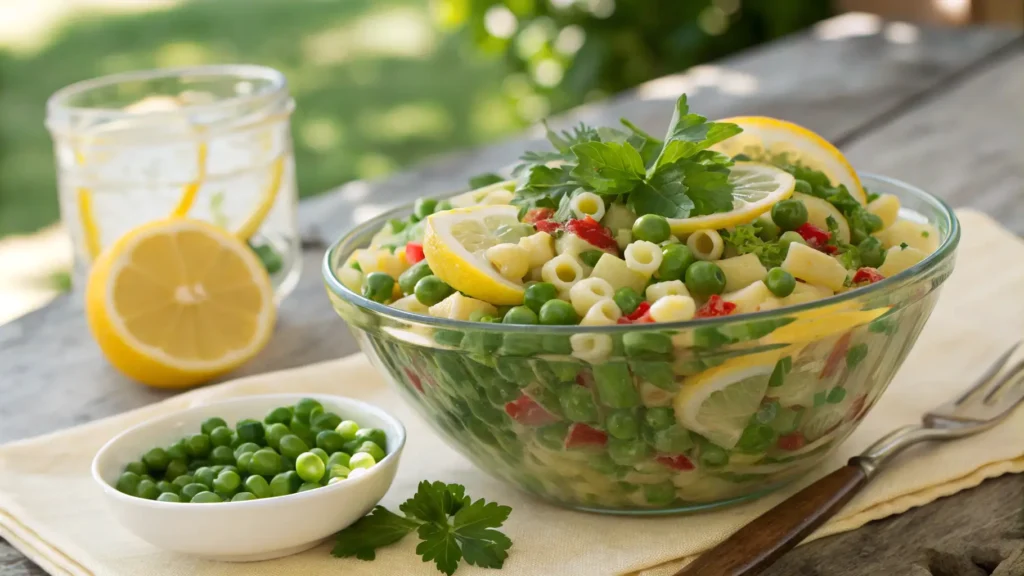
Wines That Pair Well:
- Pinot Grigio: A light, crisp white wine that complements the sweetness of peas.
- Vermentino: Herbal and citrusy, perfect for balancing the savory, starchy notes of the dish.
- Chianti: If you’ve added pancetta or prosciutto, a light red can enhance the richness.
Salads and Sides:
- Arugula and lemon salad: A bright, peppery contrast to creamy pasta.
- Tomato and mozzarella salad: Adds color and complements the peas’ natural sweetness.
- Toasted garlic bread: Always a win, especially for soaking up that starchy broth.
- Roasted vegetables: Like asparagus or zucchini, which mirror springtime flavors.
Whether it’s wine or salad, pairing gives your pasta and peas recipe a restaurant-worthy feel without the complexity.
Transform It into a Pasta Salad with Frozen Peas
Don’t let leftovers go to waste—your pasta and peas recipe can easily become a cold pasta salad the next day. All it takes is a slight shift in seasoning and prep.
Here’s how to turn it into a fresh lunch:
- Rinse with cold water after cooking to stop the pasta from softening further.
- Add frozen peas straight into the mix—they’ll thaw quickly without overcooking.
- Toss with olive oil, lemon juice, and chopped herbs.
- Optional add-ins: cherry tomatoes, cucumbers, feta cheese, or chickpeas for protein.
This chilled version is perfect for picnics, lunchboxes, or meal prepping ahead. It’s just another way this versatile pasta and peas recipe proves it’s more than a one-trick pony.
If you love recipes that double as both hot and cold meals, don’t miss our Best Smoked Fish Brine Recipe—ideal for hot entrées or chilled spreads.
From Classic to Creative—Other Pasta Dishes That Include Peas
Carbonara with Peas: Is It Authentic?
Traditional Roman carbonara is made with just five ingredients: pasta, eggs, cheese, black pepper, and guanciale. But outside Italy, you’ll often find variations that incorporate peas. While purists may scoff, many home cooks love the pop of sweetness that peas bring to carbonara’s rich, salty base.
So is it authentic? Not really. But does it taste amazing? Absolutely. The key is not to overdo it—add just enough peas to contrast the creaminess and cured pork without overwhelming the dish.
For a lighter spin on the carbonara theme, skip the guanciale and go full vegetarian by blending the two styles. That creates a creamy, savory version of the pasta and peas recipe with carbonara flair—ideal for when you want something more indulgent but still plant-forward.
Pasta Primavera, Alfredo, and Other Recipes Featuring Peas
Peas are a common ingredient in a variety of popular pasta dishes beyond the classic pasta and peas recipe. Their mild sweetness, bright color, and versatility make them a natural match for creamy, garlicky, or lemony sauces.
Here are a few examples:
- Pasta Primavera: A spring-inspired mix of pasta and fresh veggies. Peas add texture and color.
- Fettuccine Alfredo with Peas and Mushrooms: Creamy, cheesy, and balanced with green brightness.
- Pesto Pasta with Peas: A punch of herbaceous flavor with added protein and fiber from the peas.
- Baked Ziti with Peas: Adds subtle sweetness and balances the acidity of the tomato sauce.
The truth is, peas work with nearly any pasta base. They’re the quiet hero of the pantry—always ready to add nutrition, color, and just the right touch of sweetness.
Love building pantry-friendly meals with flexible ingredients? Don’t miss our Ultimate Wagyu Ground Beef Recipe Guide for ways to combine gourmet flavors with accessible staples.
So while the classic pasta and peas recipe stands tall on its own, don’t hesitate to explore beyond the basics. Whether it’s a cold pasta salad or a creamy Alfredo, peas are more than just a side—they’re a staple.
Conclusion: Why the Pasta and Peas Recipe Deserves a Spot in Your Weekly Rotation
The pasta and peas recipe proves that you don’t need complicated ingredients to create something flavorful, comforting, and nourishing. Whether you’re making it with fresh or frozen peas, keeping it traditional or giving it a modern spin, this one-pot dish delivers every single time.
Its cultural roots in Italy, ease of preparation, nutritional value, and flexibility for vegan or meat-friendly versions make it a must-know recipe for every home cook. From weeknight meals to weekend comfort bowls, it’s a dish that adapts to your pantry and your palate.
Looking for inspiration? Try pairing this with hearty options like our Ultimate Wagyu Ground Beef Recipe Guide for a protein-rich, balanced plate.
The next time you need something simple but satisfying, turn to this timeless bowl of pasta, peas, and love. You’ll never look at peas the same way again.
FAQs About Pasta and Peas Recipe
Can you cook pasta and peas together?
Yes, and that’s the beauty of the pasta and peas recipe—it’s a true one-pot dish. By cooking the pasta and peas in the same pot (often with broth), the pasta releases starch that naturally thickens the dish, creating a creamy texture without the need for dairy.
Do Italians add peas to pasta?
They do, especially in southern Italy. Peas are used in several classic dishes, including pasta e piselli, a traditional Neapolitan version of the pasta and peas recipe made with onion, olive oil, and sometimes tomato or pancetta.
When should you add frozen peas to pasta?
Add frozen peas during the last 3–4 minutes of cooking. This ensures they stay bright and tender without overcooking. In a one-pot pasta and peas recipe, toss them in just after adding the pasta to simmer together.
What do you call pasta and peas in Italy?
In Italian, it’s called “pasta e piselli.” It’s a popular home-style dish, especially in Naples, known for its creamy texture and minimal ingredients.
Do pasta and peas make a complete protein?
Yes, when eaten together, they form a complementary protein. Pasta provides some amino acids and peas provide others, so together they supply all the essentials your body needs.
Can I put frozen peas in a pasta salad?
Absolutely. Frozen peas are great in pasta salads—they thaw quickly and add a pop of color and sweetness. Just rinse them under cold water before mixing into the dish.
What to make with peas?
Beyond the classic pasta and peas recipe, you can use peas in risottos, frittatas, soups, stir-fries, or even mashed into dips. They’re one of the most flexible freezer staples.
How to make homemade carbonara?
Authentic carbonara uses pasta, eggs, Pecorino Romano, black pepper, and guanciale—no cream. For a twist, some cooks add peas to balance the richness, though that’s not traditional.
What do they call spaghetti sauce in Italy?
It depends on the sauce. Tomato-based sauces are often called sugo di pomodoro or ragù. “Marinara” in the U.S. is often a simple tomato and garlic sauce in Italy.
What pasta dish has peas?
Besides the classic pasta and peas recipe, dishes like carbonara, primavera, Alfredo with peas, and baked ziti with veggies often include peas for flavor and color.
How do Italians eat peas?
Italians use peas in a variety of ways—mixed with pasta, served with risotto, or as a side with meats. They’re often lightly sautéed with olive oil, onions, and herbs.
Have you given our recipe a try?
There are no reviews yet. Be the first one to write one.
